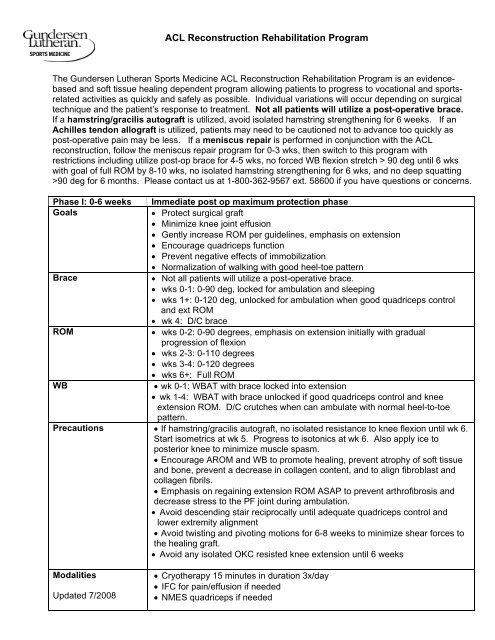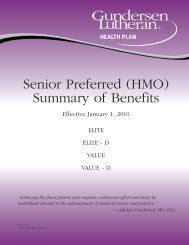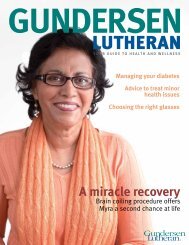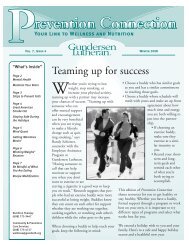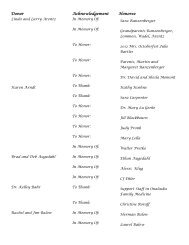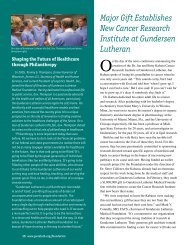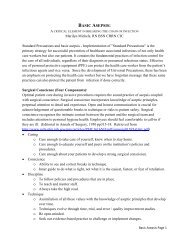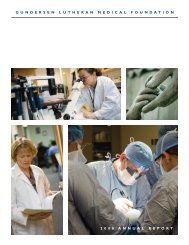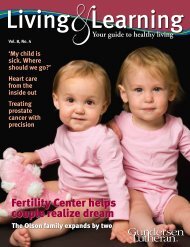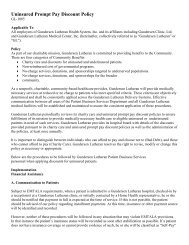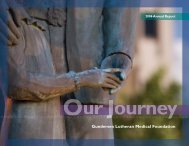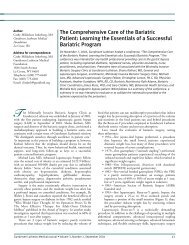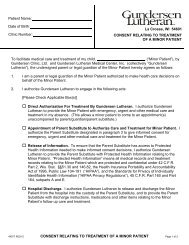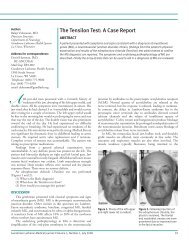ACL Reconstruction Rehabilitation Program - Gundersen Health ...
ACL Reconstruction Rehabilitation Program - Gundersen Health ...
ACL Reconstruction Rehabilitation Program - Gundersen Health ...
You also want an ePaper? Increase the reach of your titles
YUMPU automatically turns print PDFs into web optimized ePapers that Google loves.
<strong>ACL</strong> <strong>Reconstruction</strong> <strong>Rehabilitation</strong> <strong>Program</strong><br />
The <strong>Gundersen</strong> Lutheran Sports Medicine <strong>ACL</strong> <strong>Reconstruction</strong> <strong>Rehabilitation</strong> <strong>Program</strong> is an evidencebased<br />
and soft tissue healing dependent program allowing patients to progress to vocational and sportsrelated<br />
activities as quickly and safely as possible. Individual variations will occur depending on surgical<br />
technique and the patient’s response to treatment. Not all patients will utilize a post-operative brace.<br />
If a hamstring/gracilis autograft is utilized, avoid isolated hamstring strengthening for 6 weeks. If an<br />
Achilles tendon allograft is utilized, patients may need to be cautioned not to advance too quickly as<br />
post-operative pain may be less. If a meniscus repair is performed in conjunction with the <strong>ACL</strong><br />
reconstruction, follow the meniscus repair program for 0-3 wks, then switch to this program with<br />
restrictions including utilize post-op brace for 4-5 wks, no forced WB flexion stretch > 90 deg until 6 wks<br />
with goal of full ROM by 8-10 wks, no isolated hamstring strengthening for 6 wks, and no deep squatting<br />
>90 deg for 6 months. Please contact us at 1-800-362-9567 ext. 58600 if you have questions or concerns.<br />
Phase I: 0-6 weeks Immediate post op maximum protection phase<br />
Goals<br />
• Protect surgical graft<br />
• Minimize knee joint effusion<br />
• Gently increase ROM per guidelines, emphasis on extension<br />
• Encourage quadriceps function<br />
• Prevent negative effects of immobilization<br />
• Normalization of walking with good heel-toe pattern<br />
Brace<br />
• Not all patients will utilize a post-operative brace.<br />
• wks 0-1: 0-90 deg, locked for ambulation and sleeping<br />
• wks 1+: 0-120 deg, unlocked for ambulation when good quadriceps control<br />
and ext ROM<br />
• wk 4: D/C brace<br />
ROM<br />
• wks 0-2: 0-90 degrees, emphasis on extension initially with gradual<br />
progression of flexion<br />
• wks 2-3: 0-110 degrees<br />
• wks 3-4: 0-120 degrees<br />
• wks 6+: Full ROM<br />
WB<br />
• wk 0-1: WBAT with brace locked into extension<br />
• wk 1-4: WBAT with brace unlocked if good quadriceps control and knee<br />
extension ROM. D/C crutches when can ambulate with normal heel-to-toe<br />
pattern.<br />
Precautions • If hamstring/gracilis autograft, no isolated resistance to knee flexion until wk 6.<br />
Start isometrics at wk 5. Progress to isotonics at wk 6. Also apply ice to<br />
posterior knee to minimize muscle spasm.<br />
• Encourage AROM and WB to promote healing, prevent atrophy of soft tissue<br />
and bone, prevent a decrease in collagen content, and to align fibroblast and<br />
collagen fibrils.<br />
• Emphasis on regaining extension ROM ASAP to prevent arthrofibrosis and<br />
decrease stress to the PF joint during ambulation.<br />
• Avoid descending stair reciprocally until adequate quadriceps control and<br />
lower extremity alignment<br />
• Avoid twisting and pivoting motions for 6-8 weeks to minimize shear forces to<br />
the healing graft.<br />
• Avoid any isolated OKC resisted knee extension until 6 weeks<br />
Modalities<br />
Updated 7/2008<br />
• Cryotherapy 15 minutes in duration 3x/day<br />
• IFC for pain/effusion if needed<br />
• NMES quadriceps if needed
Treatment<br />
Recommendations<br />
Guidelines for<br />
progression based on<br />
tolerance<br />
Phases of graft<br />
remodeling<br />
Phase II: 6-12 weeks<br />
Goals<br />
ROM<br />
• Active warm-up (Bike AAROM progress to Bike with resistance, Nu Step)<br />
• Stretching to attain full extension with gradual progression of flexion. Goal of<br />
full ROM by wk 6. Emphasis on full return of knee extension ASAP.<br />
Low-load long duration stretching for extension with heat if needed<br />
(1 st TERT= Total End Range Time)<br />
Manual stretching for extension with overpressure / recurvatum<br />
Patellar mobilizations<br />
PROM / AAROM / AROM<br />
Manual stretching into flexion (initially limited by knee joint effusion)<br />
wk 4: WB stretch on leg press for knee flexion ROM<br />
• Flexibility exercises for hamstring, gastoc-soleus<br />
• Scar tissue massage<br />
• Therapeutic exercises. Gentle strengthening protecting the surgical graft.<br />
Exercise in a pain-free manner. Encourage quadriceps activation. Avoid<br />
dynamic valgus during strengthening and functional activities (focus on hip<br />
abductor and external rotator strengthening). Incorporate total leg<br />
strengthening and balance / proprioception exercises. No isolated OKC<br />
resisted knee extension.<br />
Biofeedback QS, SLR (if no lag), CKC knee extension<br />
Hip 4 way SLR, sidelying hip ER<br />
Gastroc soleus strengthening<br />
Hamstring OKC isotonics 0-90 deg in seated position<br />
CKC exercises: Heel raises, weight shifts, leg press and wall<br />
squats (0-60 deg)<br />
wk 2: Leg press and wall squats (0-90 deg), lateral stepovers,<br />
step-ups, partial BW squats with UE<br />
support as needed, retro TM walking for knee ext,<br />
forward TM walking for gait training<br />
wk 3: Partial lunges front and lateral, leg press 2:1, BW squats<br />
progress ROM and balance<br />
wk 4: Elliptical Runner, leg press 2:1 and 1:1<br />
wk 5: Resisted sidestep with T-band, partial dead lifts, Bosu<br />
partial squats 0-60 deg<br />
Total leg strengthening<br />
Balance / Proprioception training: Double leg progress to single leg,<br />
static progressing to dynamic activities. Perturbation<br />
exercises<br />
CV conditioning / Core Stability<br />
• IFC for pain/effusion, NMES for quadriceps activation and control as needed<br />
• Ice (in stretch for extension if needed) 2 nd TERT<br />
• HEP for 3 rd TERT<br />
Revascularization and ligamentization occur over 12 month period with peak<br />
maturity evident between 6 to 12 months following surgery.<br />
• wk 0-3: Graft necrosis with gradual replacement cells. Graft is nourished by<br />
synovial fluid so ROM is crucial.<br />
• wk 1-6-16: Graft revascularization begins, continuing through wk 16.<br />
(Based on canine study)<br />
• wk 3-24: Cellular repopulation begins, continuing through wk 24.<br />
• wk 6-52: Collagen structural formation with remodeling occurring up to 1<br />
year.<br />
Moderate protective phase<br />
• Minimize knee joint effusion<br />
• Gently increase ROM with goal of full ROM by 6-8 weeks<br />
• Gradual progression of therapeutic exercises for strengthening, stretching,<br />
and balance<br />
• Progress to full ROM by 6-8 weeks.
Brace<br />
• Knee sleeve may be utilized depending on patient activities<br />
Modalities<br />
• Cryotherapy 15 minutes in duration 1-2x/day<br />
• IFC for pain/effusion if needed<br />
• NMES quadriceps if needed<br />
Precautions<br />
• Avoid quick twisting and pivoting motions for 10-12 wks to minimize shear<br />
forces.<br />
• Implement quadriceps isotonic strengthening from 30-90 deg to avoid shear<br />
forces to the healing graft.<br />
Treatment<br />
• Active warm-up: Bike with resistance, Nu Step, Treadmill walking<br />
Recommendations • Stretching for full extension and flexion as needed.<br />
Low-load long duration stretching with heat if needed<br />
(1 st TERT= Total End Range Time)<br />
Guidelines for<br />
Manual stretching for extension and/or flexion<br />
progression<br />
Leg press stretch for flexion<br />
based on tolerance • Flexibility exercises for hamstring, gastoc-soleus, iliopsoas,<br />
• Therapeutic exercises: Exercise in a pain-free manner. Avoid dynamic valgus<br />
during strengthening and functional activities. Incorporate total leg<br />
strengthening and balance / proprioception exercises.<br />
Biofeedback<br />
Total leg strengthening<br />
Hip strengthening<br />
Heel raises<br />
Hamstrings isotonics prone 0-90 deg<br />
Wk 8: Quadriceps isotonics 30-90 deg if minimal chondrosis<br />
CKC exercises: Leg press 1:1, step-ups/step downs, Squats, Bosu 90<br />
deg squats<br />
wk 7: Lunges to 90 deg, dead lifts, sideshuffle with T-band<br />
wk 8: Stairmaster, Euroglide, hamstring curls with physio ball<br />
wk 9: Sub-max impact activities, isokinetic quadriceps/hamstrings<br />
30-90 deg VSRP 150-300 deg/sec submax to max,<br />
progressing to 300 deg/sec.<br />
Balance / Proprioception training: Single leg stance activities<br />
static progressing to dynamic activities. Perturbation<br />
exercises<br />
CV conditioning / Core Stability<br />
• IFC for pain/effusion / NMES for quadriceps activation and control as needed<br />
• Ice (in stretch if needed) 2 nd TERT<br />
• HEP for 3 rd TERT if needed<br />
Independent<br />
• wk 8-10: Progress to independent strengthening program with monthly<br />
strengthening<br />
rechecks if good ROM, minimal effusion or pain, and good muscle control<br />
Phase III: 12+ wks Advanced strengthening and Return to activity phase<br />
Goals<br />
• Progress muscle strength, endurance, and balance activities. Ideally 3x/week<br />
of exercises at a fitness center, step-down, or home program<br />
• Progress to higher level activities depending on functional demands and MD<br />
approval<br />
• Return back to vocational, recreational, and sport activities<br />
Brace • Your MD may recommend a knee sleeve or functional brace to be used until 12<br />
months from your surgery for higher level activities<br />
Modalities<br />
• Cryotherapy 15 minutes 1x/day or after strenuous activity
Treatment<br />
Recommendations<br />
• Active warm-up: Bike, Elliptical Runner, Nu Step, Treadmill walking<br />
• Continue with stretching and flexibility exercises as needed<br />
• Strengthening and endurance exercises: Advance as tolerated with emphasis<br />
on functional strengthening. Avoid dynamic valgus during strengthening and<br />
functional activities.<br />
Total leg strengthening<br />
Hip strengthening<br />
Heel raises<br />
Hamstring full ROM isotonics<br />
Quadriceps isotonics 30-90 if minimal chondrosis<br />
CKC exercises: Leg press, multiple direction lunges and step-ups, squats,<br />
sideshuffle with T-band<br />
Gastroc soleus exercise<br />
Isokinetic quadriceps/hamstrings 30-90 if minimal chondrosis<br />
Stairmaster, Euroglide<br />
• Dynamic balance exercises<br />
• CV conditioning and core stability<br />
• Ice<br />
Testing • wk 12 (3 months): Linea, Biodex 30-90 deg at 180 and 300 deg/sec, KT 1000<br />
• wk 16 (4 months): Linea, Biodex, 30-90 deg at 90, 180, 300 deg/sec, KT 1000<br />
• wk 20-24 (5-6 months): Linea, Biodex 0-90 deg at 60 or 90, 180, 300 deg/sec,<br />
KT 1000, Functional testing<br />
Return to sport /<br />
work guidelines<br />
• wk 12 (3 months): Return to running program if MD clearance, no pain or<br />
effusion, strength scores on Linea of 75%<br />
• wk 16 (4 months): Plyometrics, agility drills, pivoting and cutting maneuvers<br />
• wk 20-24 (5-6 months): Return back to sports based on MD approval, minimal<br />
pain at rest or with activity, no knee joint effusion, full pain-free ROM, isokinetic<br />
strength and functional testing at 90 % compared to uninvolved side, good<br />
performance on functional testing (90% compared to normative data or<br />
contralateral extremity) and adequate performance on sport-specific drills<br />
<strong>ACL</strong> <strong>Reconstruction</strong> <strong>Program</strong> References<br />
Accelerated <strong>Rehabilitation</strong> Following <strong>ACL</strong> <strong>Reconstruction</strong> using Ipsilateral Patellar Tendon Graft<br />
Protocol printed from SportsMedRx.com, 2003<br />
Beynnon BD, Johnson RJ. Anterior cruciate ligament injury rehabilitation in athletes. Biomechanical<br />
considerations. Sports Medicine, 1996; 22(1): 54-64<br />
Brandsson S, Faxen E, Kartus J, et al. A prospective four to seven year follow-up after arthroscopic<br />
anterior cruciate ligament reconstruction. Scand J of Med and Science in Sports, 2001; 11(1):<br />
23-27<br />
Davies GJ, Heiderscheit B, Clark M. Open kinetic chain assessment and rehabilitation. Athletic Training:<br />
Sports health care perspectives, 1995; 1(4): 347-370<br />
Davies GJ, Zillmer DA: Functional progression of exercise during rehabilitation in Knee Ligament<br />
<strong>Rehabilitation</strong>, Ellenbecker, 2000; 345-360<br />
Delay BS, Smolinski R, Wind WM, Bowman DS. Current practices and opinions in <strong>ACL</strong> reconstruction<br />
and rehabilitation: Results of a survey of the American Orthopaedic Society for Sports
Medicine (Summary). Am J of Knee Surgery, 2001; 14(2): 85-91<br />
Fagenbaum R, Darling W. Jump landing strategies in male and female college athletes and the<br />
implications of such strategies for <strong>ACL</strong> injury. Am J of Sports Med, 2003; 31: 233-240<br />
Falconiero RP, DiStefano VJ, Cook TM. Revascularization and ligamentization of autogenous anterior<br />
cruciate ligament grafts in humans. Arthroscopy, 1998, 14: 197-205.<br />
Feller JA, Webster KE. A randomized comparison of patellar tendon and hamstring tendon<br />
anterior cruciate ligament reconstruction. Am J of Sports Med, 2003; 31, 564-573<br />
Fitzgerald, KG. Open versus closed kinetic chain exercise: Issues in rehabilitation after anterior<br />
cruciate ligament reconstructive surgery. Physical Therapy, 1997; 77: 1747-1754<br />
Heckmann TP, Noyes FR, Barber-Westin SD. Autogeneic and allogeneic anterior cruciate ligament<br />
rehabilitation. In Knee Ligament <strong>Rehabilitation</strong>, Ellenbecker 2000: 132-148<br />
Kartus KJ, Stener S, Kohler K, et al. Is bracing after anterior cruciate ligament reconstruction<br />
necessary? A 2 year follow-up of 78 consecutive patients rehabilitated with or without a brace.<br />
Knee Surgery, Sports Traumatology, Arthroscopy, 1997; 5(3): 157-161<br />
Kuechle DK, Pearson SE, Beach WR, et al. Allograft <strong>ACL</strong> reconstruction in patients over 40 years of<br />
age. Arthroscopy, 2002; 8: 845-853<br />
Linn RM, Fischer DA, Smith JP, et al. Achilles tendon allograft reconstruction of the anterior cruciate<br />
ligament deficient knee. Am J of Sports Med, 1993; 21(6): 825-831<br />
Mangine RE, Kremchek TE. Evaluation-based protocol of the anterior cruciate ligament. J of Sport<br />
Rehab, 1997; 6: 157-181<br />
Manske RC, Prohaska D, Livermore R. Anterior Cruciate Ligament <strong>Reconstruction</strong> Using the Hamstring-<br />
Gracilis Tendon Autograph. In Postsurgical Orthopedic Sports <strong>Rehabilitation</strong> of Knee and Shoulder. Ed<br />
Manske RC. 2006: 189-206.<br />
Martinek MV, Friederich NF. To brace or not to brace? How effective are knee braces in<br />
rehabilitation. Orthopade, 1996; 28(6): 565-570<br />
Neitzel JA, Kernozek TW, Davies GJ: Loading response following <strong>ACL</strong> reconstruction during the<br />
parallel squat exercises. Clinical Biomechanics, 2002; 17(7): 551- 554<br />
McClure PW, Blackburn LG, Dusold C. The use of splints in the treatment of joint stiffness:<br />
biological rational and algorithm for making clinical decisions. Phy Ther,1994 74:1101-1107<br />
Millett PJ, Wickiewicz TL, Warren RF. Motion loss after ligament injuries to the knee. Part II:<br />
Prevention and treatment. American Journal of Sports Medicine, 2001; 29: 822-828<br />
Mikkelsen C, Werner S, Eriksson E. Closed kinetic chain alone compared to combined open andCKC<br />
exercises for quads strengthening after <strong>ACL</strong> reconstruction with respect to return to sports: a prospective<br />
matched follow-up study. Knee Sur, Sports Trau, Arthr, 2000; 8: 337-42<br />
Muneta T, Sekiya I, Ogiuchi T, et al. Effects of aggressive early rehabilitation of the outcome of<br />
<strong>ACL</strong> reconstruction with multi-strand semitendinosus tendon. Internal Orthopaedics, 1998;<br />
22: 352-6<br />
Rebel M, Paessler HH. The effect of knee brace on coordination and neuronal leg muscle control: an<br />
early postoperative functional study in <strong>ACL</strong> reconstructed patients. Knee Surg, Sports
Trauma, Arthro, 2001; 9(5): 272- 281<br />
Risberg MA, Mork M, Jenssen HK, Holm I. Design and implementation of a neuromuscular training<br />
program following <strong>ACL</strong> reconstruction. J of Ortho and Sports Phy Ther, 2001; 31: 620-31<br />
Sapega AA, Quedenfeld TC. Biophysical factors in range of motion exercises. Physician and<br />
Sports Medicine, 1981; 9: 57-65<br />
Seo JG, Cho DY, Kim KY. <strong>Reconstruction</strong> of the anterior cruciate ligament with Achilles tendon<br />
autograft. Orthopaedic Surgery in Korea, 1993; 16(6): 719-724<br />
Shelburne KB, Pandy MG. Determinants of cruciate-ligament loading during rehabilitation<br />
exercise. Clinical Biomechanics, 1998; 13: 403-413<br />
Shelbourne DK, Rask BP: Controversies with anterior cruciate ligament surgery and rehabilitation.<br />
American Journal of Knee Surgery, 1998; 11(2): 136-143<br />
Tsaklis P, Abatzides G. <strong>ACL</strong> rehabilitation program using a combined isokinetic and isotonic<br />
strengthening protocol. Isokinetics Exercise Science, 2002; 10: 211-9<br />
Tsuda E, Okamura Y, Ishibashi Y. Techniques for reducing anterior knee symptoms after <strong>ACL</strong> using<br />
a bone-patellar tendon-bone autograft. American Journal Sports Medicine, 2001; 29: 450-456<br />
Wu GK, Ng GY, Mak AF. Effects of knee bracing on the sensorimotor function of subjects with <strong>ACL</strong><br />
reconstruction. Am J of Sports Med, 2001; 29(5): 641-645


